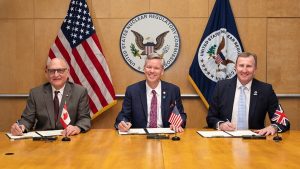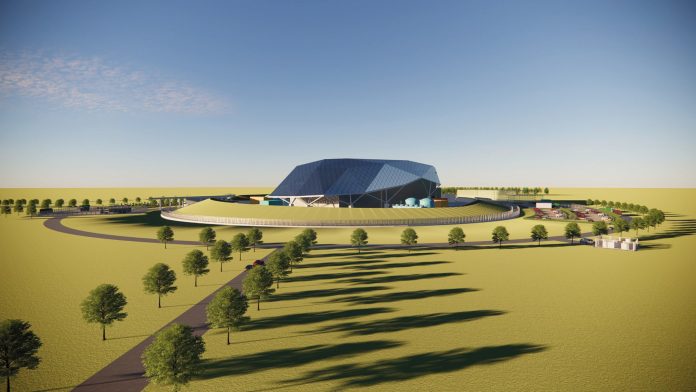Tim Parkes and Karen Garesse detail how the Office for Nuclear Regulation is responding to the UK government’s challenge for all regulators to consider how processes can be streamlined to support effective nuclear power expansion.
Following the January 2024 launch of the government’s Civil Nuclear Roadmap as part of its energy security and net zero plans, we stand ready to independently regulate the country’s anticipated growing nuclear sector.
The UK has a widely respected regulatory system and we have been preparing for the expansion of nuclear for some time.
Throughout our work on the Advanced Nuclear Technologies (ANT) programme, we have:
• Developed our capability and capacity to regulate light water small modular reactors (SMRs) and the next generation of advanced modular reactors (AMRs);
• Reviewed our guidance and processes to ensure they are fully compatible with the regulation of SMRs.
• Advised the Department for Energy Security and Net Zero (DESNZ) on its AMR Research, Development and Demonstration (RD&D) programme.
• Engaged with regulators internationally, including participation in International Atomic Energy Agency and Nuclear Energy Agency forums.
• Provided regulatory advice to vendors.
• Streamlined the Generic Design Assessment (GDA) process and provided greater clarity on options for design assessment.
• Considered how to streamline our licensing process.
• Developed a new early engagement process.
We responded to the challenge set by the UK government’s Energy Security Strategy for all regulators to consider how their processes can be accelerated.
To maximise potential for this, ONR is continuing to innovate how we engage with vendors, developers, aspirant licensees and international regulators.

Two significant milestones that we achieved earlier this year are:
• The launch of the joint ONR and Environment Agency Early Engagement process1 for organisations wishing to deploy nuclear reactor technology.
• Signing a trilateral Memorandum of Cooperation between the UK’s Office for Nuclear Regulation (ONR), Canadian Nuclear Safety Commission (CNSC) and US Nuclear Regulatory Commission (NRC).2
Early engagement
Early engagement is a voluntary process which is available to any party requesting early regulatory engagement on a proposed nuclear reactor deployment in Great Britain – including reactor technology vendors, developers, or aspirant licence/permit holders (or a consortia of these).
Launching the early engagement process enabled us to meet a key part of the government’s civil nuclear roadmap to 2050, delivering our commitment to enabling regulation and supporting innovation.
Early engagement is designed to be flexible and to help applicants develop their understanding of regulatory processes and expectations when projects are at an early stage.
It is not a prerequisite for subsequent formal processes, but it does yield benefits in enabling readiness for those processes.
It aims to:
• Facilitate access to regulators as early as possible, before undertaking more formal processes, so that organisations can benefit from early advice and guidance.
• Gain early confidence in the potential for new nuclear projects to meet regulatory expectations, so that we can make informed decisions on the deployment of regulatory resource.
How does early engagement work?
There are three approaches, or tiers, to the early engagement process:
One-day engagement
This is a single event for regulators to set out the UK regulatory framework and explain the available pathways, highlight early and major risks, and define information requirements and key hold points for each stage. It is also an opportunity for applicants to set out their proposals for deployment of reactor technology in Great Britain.
The information provided during the one-day engagement will inform our decision on whether the organisation is ready to progress to the subsequent tiers of early engagement, and on what timescales.
Regulatory process and technical engagements
This comprises a series of up to ten structured engagements on a range of topics to be agreed between the applicant and the regulators, based on technical risk, building on the one-day engagement and explaining in much greater detail the specific matters of interest.
The objective of the structured technical engagements is for regulators to gain a greater understanding of the applicant’s proposals, and to provide advice on regulatory expectations for the agreed topics.
Preliminary design review
The preliminary design review consists of a technical review of up to six regulatory submissions on specific topics agreed between the regulators and the technology vendor.
The objective is for regulators to provide advice and guidance to technology vendors on specific aspects of their designs, to identify any potentially significant shortfalls against regulatory expectations while designs are in the early stages of development, and to agree
how any shortfalls might be addressed as the design matures.
At the end of the preliminary design review, the regulators will produce a summary report. This will set out the advice provided in relation to each submission and will provide an indication of the regulators’ confidence that expectations can be met should the design be taken forward into subsequent regulatory processes.
Early Engagement Case Study – Regulatory Support to Advanced Modular Reactor Research, Development & Demonstration: Phase B
ONR has been engaging with organisations who have indicated their hope to deploy nuclear reactor technology in the UK.
For example, ONR and the Environment Agency are working jointly to carry out a focused programme of work to support the development of the projects in Phase B of the AMR RD&D programme.
In AMR RD&D Phase B, the Department for Energy Security and Net Zero is providing development funding for two high temperature gas reactor (HTGR) designs to undertake FEED+ (Front End Engineering Design and supporting activities) studies to help enable deployment of a HTGR demonstrator by the early 2030s.
Phase B is also supporting the development of a programme for manufacture of the advanced fuel required for AMRs, through the UK Coated Particle Fuel (CPF) – Step 1 Programme.
We have been providing regulatory advice and guidance to vendors going through the programme following the preliminary design review process, as described above.
Benefits we are realising through the early engagement with these organisations include:
- Improved vendor understanding of regulatory process and routes to deployment. This is allowing vendors to more accurately account for regulatory processes in their deployment plans.
- Gaining an understanding of the novel technologies proposed for deployment and operation, and the status of the safety, security and environmental justifications. This has allowed us to develop our processes and guidance to ensure we are ready to regulate effectively and efficiently when technology vendors and prospective developers are ready to proceed through formal regulatory processes.
- Vendors are gaining an understanding of key regulatory expectations and requirements for the justifications required by regulators. By receiving regulatory advice and guidance ahead of entering formal regulatory processes, applicants can de-risk later project stages.
- Through early engagement, we are gaining an understanding of the maturity and readiness of applicants to progress through the regulatory and legislative framework, which will allow us to effectively prioritise and manage the deployment of regulatory resource.
International regulatory collaboration
There are clear advantages in learning from international experience and considering this as part of regulatory decision making.
We consider the greatest potential for acceleration and streamlining of regulatory processes is offered by greater collaboration with international regulators on reactor design assessment and leveraging of technical assessments undertaken by other regulatory bodies.
When a reactor design has been assessed by an established nuclear regulator in another country, it is likely that aspects of the safety and security cases submitted to the relevant regulator could be used as the basis of submissions to the UK regulators.
If the regulatory evaluations and conclusions on those submissions are available, it is also likely that they could significantly accelerate our ability to reach a conclusion on the adequacy of the design to meet internationally-recognised standards.
The extent to which this is achievable would depend on the similarities and differences between regulatory requirements and expectations in the respective countries.
Ultimately, a future site-specific safety and security case will need to explicitly demonstrate how activities on that site meet applicable UK regulatory requirements.
We are increasingly seeing that reactor vendors are seeking to deploy their technologies in multiple countries and are engaging with regulators in those countries regarding assessment of their designs.
Where a reactor design is undergoing assessment in the UK concurrently with other countries, the assessment activities could potentially be aligned, enabling close collaboration between ourselves and international regulators.
This presents the opportunity for assessments to be ‘shared’ between regulators, thus avoiding the duplication of effort and allowing regulators to establish common positions with regard to the safety and security of new reactor designs
International Collaboration Case Study – Memorandum of Co-operation between ONR, US NRC and CNSC
In March 2024, we signed a trilateral Memorandum of Cooperation (MoC) with two international regulators to collaborate on the assessment of SMR and AMR designs.
This MoC between ONR, the US Nuclear Regulatory Commission (NRC) and the Canadian Nuclear Safety Commission (CNSC), was signed at the NRC’s Annual Regulatory Information Conference (RIC) in Maryland, United States.
The agreement signals a partnering approach that will improve both regulatory effectiveness and efficiency, which is essential given the rapid growth in reactor technologies that are seeking regulatory consideration and approval.
It will enable both good practice and experience of reviewing SMR and AMR designs to be shared between regulators, and ensure the efficient use of regulators’ time and resources through a willingness to share technical knowledge and judgements.
This streamlining of regulation maintains safety standards, acting as an exemplar of how regulators can work together in today’s global nuclear sector operating climate.
With multiple Generic Design Assessments for SMRs currently underway in the UK and abroad, the agreement will help realise opportunities for efficiency.
As part of the MoC, we are actively working with both NRC and CNSC to identify opportunities for information exchange and collaboration on our assessments of the GE-Hitachi BWRX-300 and Holtec SMR-300 reactor designs, both of which are currently undergoing GDA.
Current GDA processes
We are currently assessing three reactor designs through the GDA process. Each step gets progressively more detailed as the GDA continues and, as such, the length of steps varies.
We carry out our assessment in three steps, and an indicative timescale for a ‘full’ GDA of three steps is approximately four years.
The first step is about project mobilisation and agreeing the scope. The second step consists of a fundamental review of safety, security and safeguards by ONR and environmental protection by the Environment Agency and Natural Resources Wales.
This would identify if there are any major safety or security shortfalls, meaning a reactor would not meet regulatory expectations in its current design.
For a ‘full’ GDA, vendors will continue to Step 3 which involves a detailed assessment of their design and safety and security cases.
A design acceptance confirmation (DAC) would be issued after the successful completion of a three-step GDA, and only when we have concluded that the design is capable of being safely and securely built and operated in the UK, subject to future site-specific assessment and licensing.
Rolls-Royce SMR Ltd’s 470 MWe Small Modular Reactor (SMR) design successfully completed Step 2 and entered into Step 3 during the summer.
We are the first nuclear regulator to assess this reactor design, determining whether it meets our robust safety, security, safeguards and environmental protection standards in Great Britain.
It is also the first time we have followed the modernised GDA process, looking at an SMR design.
Holtec International’s Small Modular Reactor (SMR) design also completed Step 1 of its GDA in recent months and has entered Step 2, the fundamental assessment of the design which is expected to last for 14 months. This will be the first time we have conducted a GDA ending at Step 2.
In January, we announced that we had started a two-step GDA for GE Hitachi’s BWRX300 reactor following a review from DESNZ.
As detailed above, this GDA is actively looking to explore opportunities to maximise the value of international regulatory collaboration and identify efficiencies in processes.
References
- New Nuclear Power Plants: Early Engagement for Regulatory Pathways early-engagement-booklet-web-102.pdf
- Memorandum of Cooperation with NRC and CNSC MOC on ARs and SMRs with USA CAN and UK (onr.org.uk)









